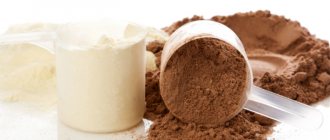Wondering which of these proteins is best for your needs? Get answers to all your questions with the help of a comparative analysis of these supplements given in this material.
Whey protein and casein are two of the most popular protein supplements on the sports nutrition market, and for good reason. Both are high quality, highly bioavailable, complete proteins that are particularly rich in branched chain amino acids (BCAAs), making them ideal for muscle growth and recovery.
However, even though they are both derived from milk, there are distinct differences between these muscle-building supplements.
Both whey and casein are milk proteins produced during the cheese-making process. In fact, all dairy products contain a mixture of whey and casein. Milk is approximately 80% casein and 20% whey.
How do whey and casein work?
Whey protein is known as a "fast" protein because it digests quickly. On the other hand, casein protein is a “slow” protein because it is digested quite slowly, gradually.
Although this protein pair has a high amino acid content, whey protein is considered more anabolic (for muscle building) due to its ability to quickly increase the levels of amino acids in the blood, which are necessary for protein synthesis.
On the other hand, casein is considered an anti-catabolic or muscle-sparing protein because it provides a steady flow of amino acids over a period of time, which inhibits the breakdown of muscle tissue.
For muscle growth, the rate of protein synthesis must be greater than the rate of muscle breakdown. Since whey increases protein synthesis and casein prevents protein breakdown, both proteins taken strategically can help you build muscle.
How do whey protein and casein work?
Whey protein is known as the "fast brother" because it digests quickly. Casein, in turn, is a “slow brother” because it is digested gradually.
Although both of the pair are high in amino acids, whey protein is considered a more anabolic (muscle-building) milk protein due to its ability to quickly increase amino acid levels in the blood, which is necessary to trigger muscle protein synthesis.
At the same time, casein is considered an anti-catabolic, or muscle-repairing, protein because it provides a steady stream of amino acids over time, inhibiting the breakdown of muscle tissue.
For muscle tissue to grow, protein synthesis must exceed its breakdown. Because whey protein increases protein synthesis and casein inhibits muscle breakdown, both proteins can help build muscle mass when used wisely.
Whey Protein
It only takes 20 minutes for this protein to be digested, absorbed into the blood, enter the body’s tissues and be absorbed. Within an hour it will be spent on each protein synthesis or oxidation. This is incredibly fast compared to casein or even dietary protein from food sources.
It is this sudden increase in amino acids that stimulates muscle protein synthesis. Whey protein quickly shifts the balance from muscle breakdown to muscle synthesis to lift you out of a catabolic state, like the one you get into when lifting weights.
Casein
When consuming casein, the maximum level of amino acids in the blood and protein synthesis is achieved after 3-4 hours. However, this peak is not even close to the performance of whey protein.
But that's good too. Although casein does not increase amino acid levels as much, it significantly slows the rate of protein breakdown, protecting existing muscle.
Whey Protein
Whey protein is digested, absorbed into the blood, absorbed by body tissues and metabolized in just 20 minutes. Within an hour it will be spent either on synthesis or oxidation. This is surprisingly fast compared to casein or even whole food dietary protein.
It is this sharp increase in amino acids that stimulates muscle protein synthesis. Whey quickly changes the balance between muscle breakdown and protein synthesis to lift you out of a catabolic state similar to weight lifting.
Which protein is better, whey or casein?
Despite their different bioactive components, whey and casein proteins differ little when it comes to their nutritional value.
A standard 31g scoop of whey protein contains ():
- Calories: 110 kcal.
- Fat: 1 g.
- Carbohydrates: 2 g.
- Protein: 24 g.
- Iron: 0% Recommended Daily Intake (RDI).
- Calcium: 8% of the RDI.
A standard scoop (34 g) of casein protein contains ():
- Calories: 120 kcal.
- Fat: 1 g.
- Carbohydrates: 4 g.
- Protein: 24 g.
- Iron: 4% of RDI.
- Calcium: 50% of the RDI.
Keep in mind that these nutrition facts may vary depending on the specific brand you buy, so be sure to read labels carefully.
Moreover, there are other factors:
- Casein protein powder is usually more expensive than whey protein powder.
- Whey protein powder tends to mix better than casein protein powder.
- Whey protein often has a better consistency and taste than casein protein.
You can also buy protein powders, which usually contain a combination of casein and whey, giving you the benefits of each.
Alternatively, you can buy both powders individually and take the whey protein during or after your workout (see When is the best time to take protein) and the casein protein before bed.
How to use
You can mix each type of protein with water or milk. Milk will thicken your protein shakes (especially casein shakes).
If possible, mix the protein powder and liquid in a blender bottle or regular blender rather than using a spoon. This will ensure a more even consistency and dispersion of the protein.
Always add the liquid first and then the scoop of protein. This order keeps the whites from sticking to the bottom of your container.
Summary:
Casein and whey proteins offer unique benefits. When you compare which one is better, you can also consider cost, mixability, and taste. Moreover, you can mix both types together.
When and what protein to take
Because whey protein is quickly digested, it is great before, during, or after workouts because it quickly fuels your muscles with minimal gastrointestinal upset. (If you have problems digesting milk, in which case you should avoid milk proteins).
On the other hand, casein is best consumed before fasting, such as before bed or a long day when there is no opportunity to eat, because the slow release of amino acids promotes satiety. It can also be added to dishes.
Slow absorption of casein can be a negative thing before or after a workout when you're trying to quickly deliver amino acids to the body, but it's beneficial when it comes to curbing hunger and catabolism when you're trying to lose weight.
Mixing whey protein and casein
Some people also like to mix both proteins post-workout. The idea is that this way you get both fast-acting and long-lasting amino acids.
However, others believe that mixing the two protein powders blunts the amino acid surge from whey protein and slows its absorption. Try both approaches to find out what works best for you. The most important thing is to make sure you are getting plenty of amino acids.
How to Use Whey and Casein Protein Powders
Whey protein powder is extremely versatile: it mixes great with water or milk, but also pairs well with oats, Greek yogurt, peanut butter, or in a protein shake. If you enjoy baking, try adding whey protein to your recipe.
Casein protein is a great pre-bed snack. Simply mix it with a little water or milk to make casein pudding.
You can add it to some Greek yogurt (which itself is a fantastic source of casein) or make a slightly fancier snack with a whey and casein mixture.
Casein protein
This type of protein is made from milk and is also called “curd protein.” The process of its production occurs by curdling milk, and in natural food casein protein is also most found in cottage cheese. Casein protein differs in degree of purification: it is divided into calcium caseinate and micellar (purer) casein. Casein protein is very expensive, costing about 30% more than whey protein. This casein is ideal to take before bed as it is absorbed slowly. It contains all the essential amino acids, including approximately 15% BCAA.
Casein and Whey Research
The study involved healthy people who regularly take the usual amount of protein. They fasted for 10 hours, then were given 30 grams of whey protein or 30 grams of casein.
Leucine levels in the blood peaked an hour after taking whey or casein. However, the whey protein group peaked at higher levels and returned to baseline levels after four hours.
The casein protein group peaked at a lower level but returned to baseline only after seven hours.
Whey protein increased protein synthesis by 68% but did not affect protein breakdown. Casein reduced protein degradation by 34% but did not affect protein synthesis.
As mentioned earlier, research points to benefits from both proteins. Keep in mind that mixed protein foods (as opposed to single protein supplements) will have a different absorption rate, which may affect protein synthesis and breakdown.
With the information from the above study, we can question the general recommendation of eating every three hours to avoid losing muscle mass.
By taking protein supplements, especially casein, you can maintain high amino acid levels in your body between meals for much longer.
Interestingly, another study concluded that ingestion of either type of milk protein post-workout resulted in a similar increase (without significant differences) in net muscle protein balance, resulting in net muscle protein synthesis, despite different patterns of amino acid reactions in the blood.
This suggests that while it is preferable to take whey protein during training and casein during fasting, the most important thing is to get enough protein in general, whether it be whey, casein, plant-based protein powder, or any other protein source.
What determines protein quality?
All food proteins are not equally valuable to the body; some are more valuable than others. Therefore, each type of protein is assigned a biological value , as we noted in other articles about proteins.
The quality of protein depends primarily on the source of the protein (milk, egg, soy, etc.), as well as on the method of physical and chemical processing to which it was subjected, and of course on the body’s ability to absorb it.
Currently, bodybuilders mainly opt for whey and casein protein (milk protein).
Whey protein is an excellent choice, first of all:
- high biological value (BC) - 100
- high content of essential amino acids (especially branched chain amino acids - leucine , isoleucine and valine )
- pleasant taste
- gentle processing during production (no heat or acids)
- maximum saturation of muscles with amino acids
All these facts make whey protein the best choice.
All results are confirmed by clinical studies in laboratories, and most importantly, in the gym . However, you should not forget about milk and casein protein in your diet, as many do, prescribing it only bad, unproven reviews. However, this is understandable; competition in sports nutrition, especially among such a popular supplement, is so high that people are ready to do anything for their own benefit.
Many athletes who use sports supplements in their menu know that taking whey protein on an empty stomach is not advisable or effective, since it is absorbed too quickly. Indeed, whey significantly increases protein synthesis , but a huge proportion of amino acids are used for energy, instead of building muscle mass .
Quality protein
In addition, there are large differences in the quantitative and qualitative composition of this type of protein. Many athletes do not pay attention to the packaging at all, they buy whatever whey protein they need, instead of buying what they need, for example, the concentrate is cheap, has a low filtration system, the isolate is affordable, almost ideal for building muscles, and hydrolysate is very expensive, protein It is split into fractions, so it is absorbed instantly.
Casein, unlike whey, is digested slowly and gradually saturates the muscles with amino acids . Casein does not stimulate protein synthesis as strongly as whey, but it does have a powerful anti-catabolic effect that whey does not. In addition, the combination of casein and whey protein slows down the absorption of whey, thereby protecting the amino acids of the latter, and maximizing their use by muscles for protein synthesis. This benefit from the combination of proteins, casein and whey, is one of the main reasons why such protein mixtures are sold by sports nutrition stores.
What is casein?
Casein is a protein that, like whey, is obtained from the milk of mammals. Many people consume casein in the form of cow's milk . We are talking about the insoluble part of milk, which makes up approximately 80% of milk proteins . The soluble part of milk and the remaining 20% is whey. [1]
Casein is also an integral part of cheese production . It has the ability to change its consistency to a gel and therefore acts as a binding agent. During digestion, casein gel mixes with stomach acid. This reduces the rate of casein absorption and allows for a slower, more consistent and more efficient release of amino acids . A slow digestion rate is also beneficial because it increases the feeling of fullness. [2]
We know two forms of casein [3]:
- micellar casein is the most popular and slow-soluble form of casein, which is usually produced by a microfiltration process
- hydrolyzed casein – a form of digestible casein that is absorbed more quickly
Casein, like all proteins, is a high-quality source of amino acids . Because it is an animal source, it offers a comprehensive amino acid profile and thus contains all the essential amino acids that the human body cannot produce itself. As for the composition of casein protein , then, as a rule, 33 grams of powder contains 24 grams of protein, 3 grams of carbohydrates and 1 gram of fat. Casein protein may also contain micronutrients such as calcium and phosphorus, but the resulting casein composition usually depends on the manufacturer. [1] [15]
Casein protein also contains various bioactive peptides that have great health benefits. The process of digestion of peptides partially occurs in the stomach. Even before the peptides are broken down into essential amino acids, they act in the intestines. Thanks to this process, casein has a number of positive effects , which we will discuss below. [1]
When should you take protein?
Fast-digesting whey protein is great for pre- and post-workout use. It will quickly fuel your muscles with minimal risk of stomach upset. Casein is best used when you are not going to eat for a long time, for example before bed or before a long meeting, it will provide a long-term supply of amino acids and a feeling of fullness.











